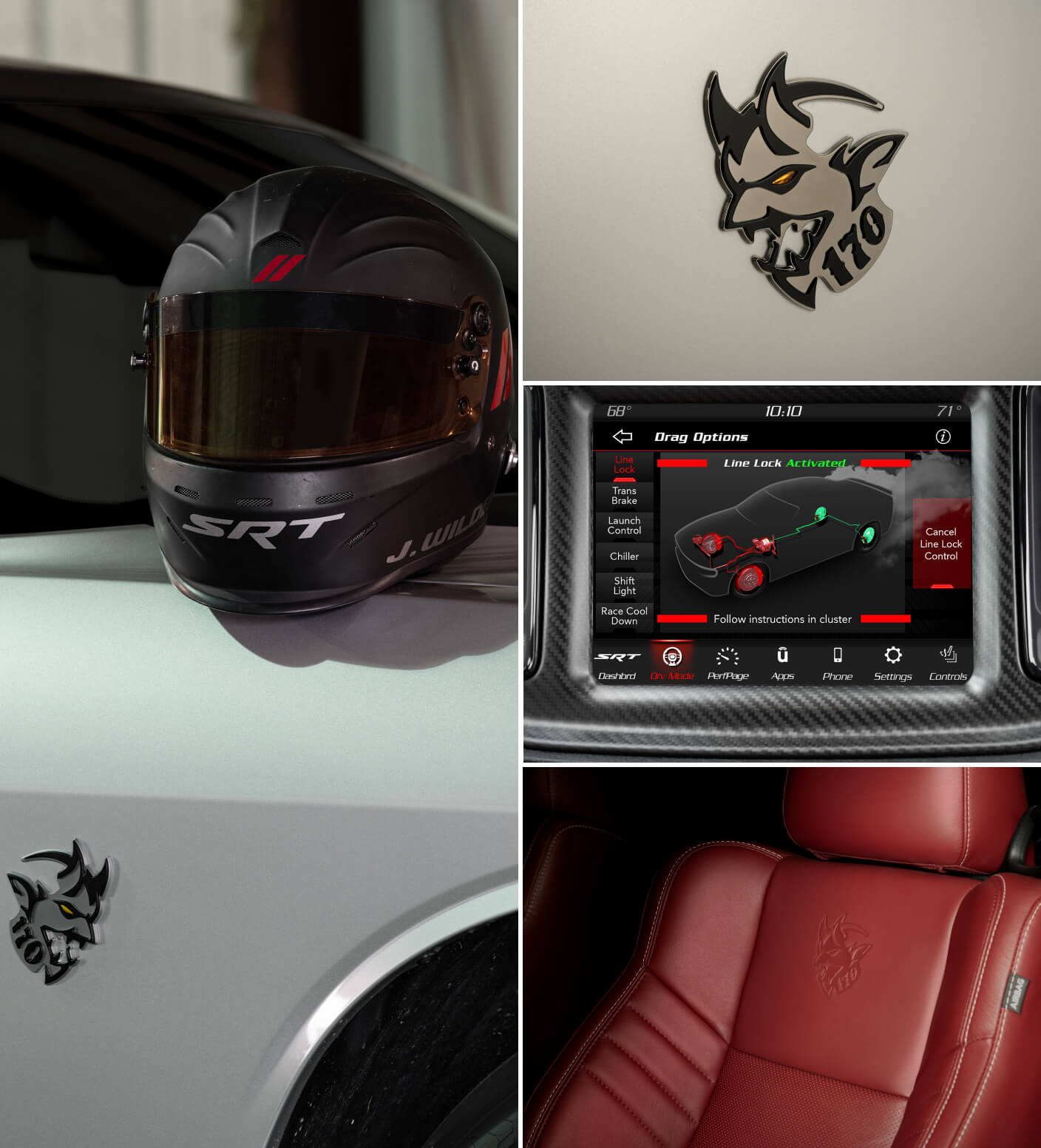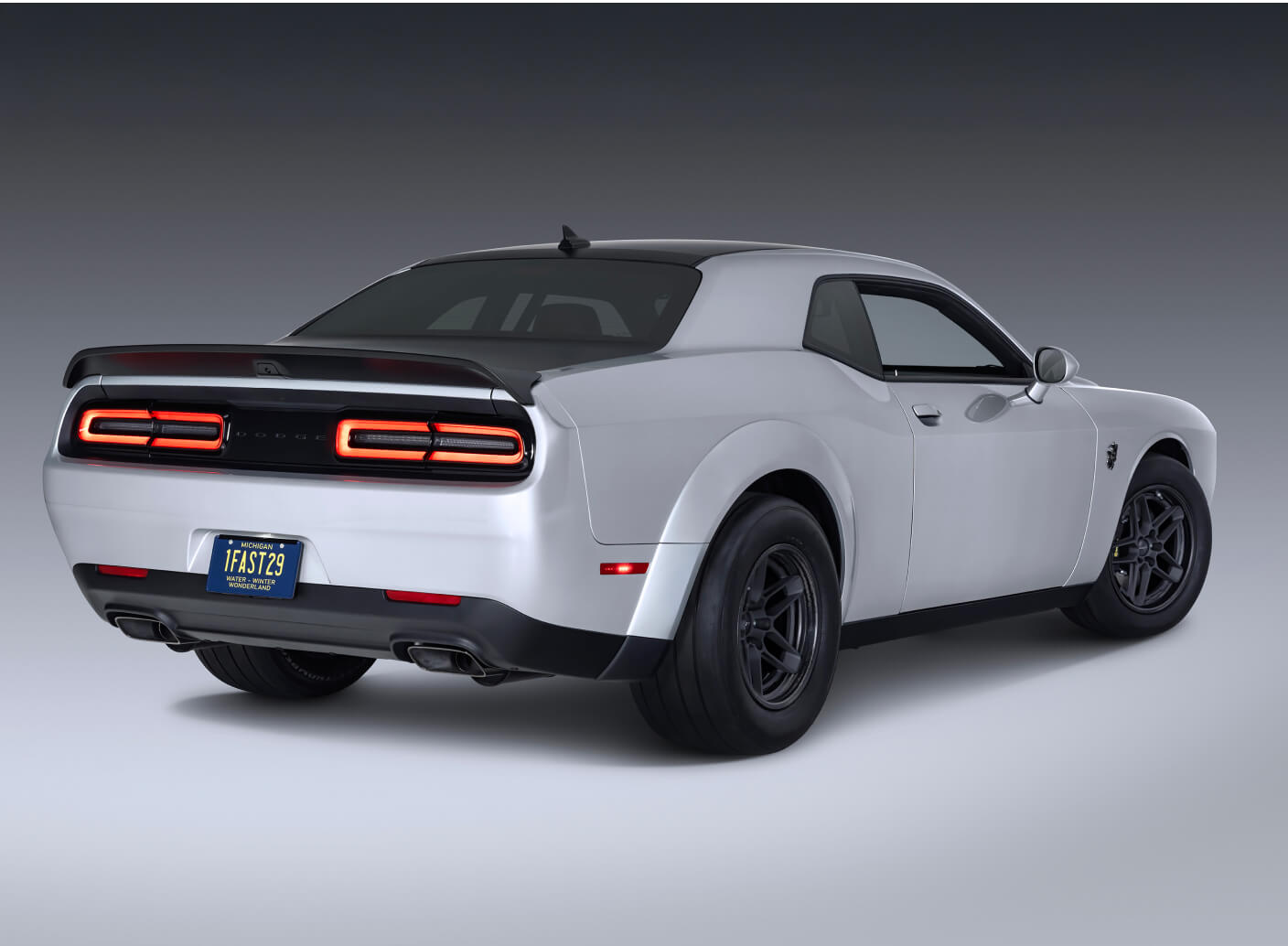The Dodge Challenger SRT Demon 170

2023 Dodge Challenger SRT Demon 170: The Ultimate Internal-Combustion Muscle Car At a Glance
- While the other Last Call editions were a celebration of the Challenger coupe's life, the Demon 170 was a madman who kicked down the door and turned the party into a brawl.
- 1,025 horsepower, a 1.66-second 0-60 mph time, a quarter-mile run of 8.91 seconds at 151.1 mph. Everything from Mickey Thompson drag radials to an available one-seat interior makes it about as complete as a factory-built drag racer could ever be.
- The Dodge Challenger SRT Demon 170 top speed is more of a trap speed. It's dedicated to drag racing and likely will forever remain the true testament to fuel-burning muscle.
- There was one before called the 2018 Dodge Challenger SRT Demon, but none were made after. The 2023 Dodge Challenger SRT Demon 170 sadly marked the end of the Challenger as we know it.

Behold, Eights Without Aftermarket Headaches: The 2023 Dodge Challenger SRT Demon 170
Many people head to test-and-tune days with a bucket of aftermarket parts, hoping to dial in their muscle cars and get into the eight-second quarter-mile territory. After a grueling day of runs that result in trackside-wrenching sessions, they often go home upset. Now they have to add, "Fix the car all week and complain to that aftermarket company" on their to-do list.
If they had bought a Dodge Challenger SRT Demon 170, then their to-do list would likely just be, "Come back next weekend and have another day of easy fun."
It runs eights right from the factory, namely an 8.91-second ET with a 151.1-mph trap speed. Yes, you read that correctly: the Demon 170 was the first muscle car to pull off the feat of a factory-stock eight-second quarter-mile time.1
The 151-mph trap speed, effectively, is the Dodge Challenger SRT Demon 170 top speed: the Mickey Thompson drag radial tires – which come standard and each measure over a foot wide in the rear – shouldn't really be pushed any further.
But the quarter mile is where Dodge muscle shines brightest, and if you can complain about not being able to go faster than 150 mph, then you probably haven't experienced the 1.66-second posted 0-60 mph time – the fastest production-car 0-60 mph time, ever.2
Since the Dodge Challenger SRT Demon 170 0-60 time results in just over two full Gs of acceleration (the hardest pull any production car is capable of3), it's an experience like no other. Plus, it's a 3,300-unit limited edition as part of the Last Call series. It was a send-off party for the Challenger, and despite the insanity of models like the Challenger Black Ghost, the Demon 170 is still thought of as the wildest, most wicked, and most wanted Challenger.


How Are the SRT Demon Specs Even Possible?
Have you ever heard of the "Ship of Theseus" paradox? Well, that applies here. We'd like to say that the Dodge Challenger SRT Demon 170 top speed is achieved by a special version of the Hellcat engine, but so much has been changed that almost nothing from the original Hellcat engine remains.
Like the Hellcat engine, the SRT Demon model boasts a 6.2-liter supercharged HEMI V-8, but not even the block is untouched, instead being revised for new head studs and main bearing cap bolts. This is very necessary, considering what's about to happen.
That would be a whopping 21.3 PSI of boost from a new supercharger (40% more than the Hellcat Redeye), the ability to guzzle 164 gallons of fuel per hour with new injectors, fuller air flow with giant throttle bodies, and higher-pressure cylinders to ignite the fuel fully. Forged or special-alloy versions of more Hellcat engine parts come into play.
The camshaft is the sole survivor from Hellcat city.
It'll need a drink to deal with it all: at this bar, though, they only serve E85 high-ethanol fuel. That fuel, in fact, is part of how all the upgraded components put down a powerful 1,025 horsepower and 945 pound-feet of torque. You could still run it on pure gasoline, but only this ethanol can unlock the true SRT Demon horsepower output.
These further upgrades help said power shoot the car forward:
- TransBrake 2.0: Holds the car in place so that power can build and optimize launches.
- Aerospace-Grade Differential Housings and Strengthened Driveline Shafts/Axles: When that power is unleashed, it violently twists the prop shaft, slams into the differential, and flows to the wheels through half shafts. All of those parts are strengthened to take the beating in stride.
- Drag Suspension: Have you ever seen a drag racer wheelie at launch? It's a cool stunt, but not if you're aiming for a faster run. The suspension anticipates such weight transfer and keeps the wheels planted.
- Mickey Thompson Drag Radials on Forged Aluminum Wheels: Skinnies up front and meaty rubber in the rear – as a drag setup should be. As an option, the metal wheels could instead be made from carbon fiber.
- Widebody Fender Flares: How else could those tires fit?
Further enhancements are done to save weight, add strength, and optimize the car. While the Dodge Challenger SRT Demon 170 top speed will be limited by aerodynamics and those drag radials, the acceleration becomes something unbelievable thanks to all this and more.
How Is This Car Even Street-Legal?
The SRT Demon price included a standard two-speaker sound system. If SRT engineers could find a way to create the legally mandated alert sounds out of thin air, there wouldn't even be any speakers, as they are nothing but dead weight on a drag strip. This is the spirit of the Demon 170 – do what's needed to be street legal, and then go all-in on straight-line performance.
There is an Alcantara steering wheel inside, which is nice but also designed primarily for functional grip. Some Demon 170 models were optioned with a luxurious Laguna leather interior, but many stuck to weight-saving cloth.
The ability to go from zero to 60 mph in 1.66 seconds from the factory is the kind of luxury that the SRT world focuses on, and if you've read this far, it's probably your definition of automotive luxury, too.
So, while the Dodge Challenger SRT Demon 170 top speed is something only the lucky 3,000 customers could experience in a new car, you can now experience it in a used car. At the time of writing, we currently have more than one used Dodge Challenger SRT Demon 170 for sale at Aaron CDJR!
Frequently Asked Questions
What's the top speed of a SRT Demon 170?
The Dodge Challenger SRT Demon 170 top speed, while falsely reported by some sources as a 215-mph top speed, is only confirmed to be a 151-mph trap speed (the "trap" is the end of the quarter mile). The Challenger Demon 170 can likely keep accelerating, but the drag-radial tires should not be pushed any faster.
Is it street-legal?
Yep! The Dodge Challenger Demon 170, while designed to be the meanest internal-combustion factory drag racer, was also engineered to be street-legal. As such, specialized features like a roll cage are not standard equipment, as they'd make street driving a bit too unpleasant. Notably, that lack of cage caused the NHRA to ban the Demon 170 from competition.
Why was it banned by the NHRA?
The NHRA's official rules divide cars into different classes. If a car breaks into the eight-second range, then it needs equipment like a parachute and roll cage to compete in NHRA-sanctioned events. The Dodge Challenger Demon 170, essentially, was banned by the NHRA for being too fast. However, it can still be used to compete in un-sanctioned drag events.
Featured Customer Review
Fredy Vera
5 stars on 02/14/2024
I'm so happy with my purchase at [Aaron] CDJR of Norco. I was able to buy my dream car 2023 Dodge Charger. I couldn't have done it without the help of my sales person Adriel and his manager Johnny. They made the process very easy and hassle free. I totally recommend this place if you're looking for a new vehicle once again thanks guys.
1Based on quarter-mile time.
2Current production vehicles, based on 0-60 time, excludes non-mass-production vehicles.
3Current production vehicles, based on 0-60 g-force.